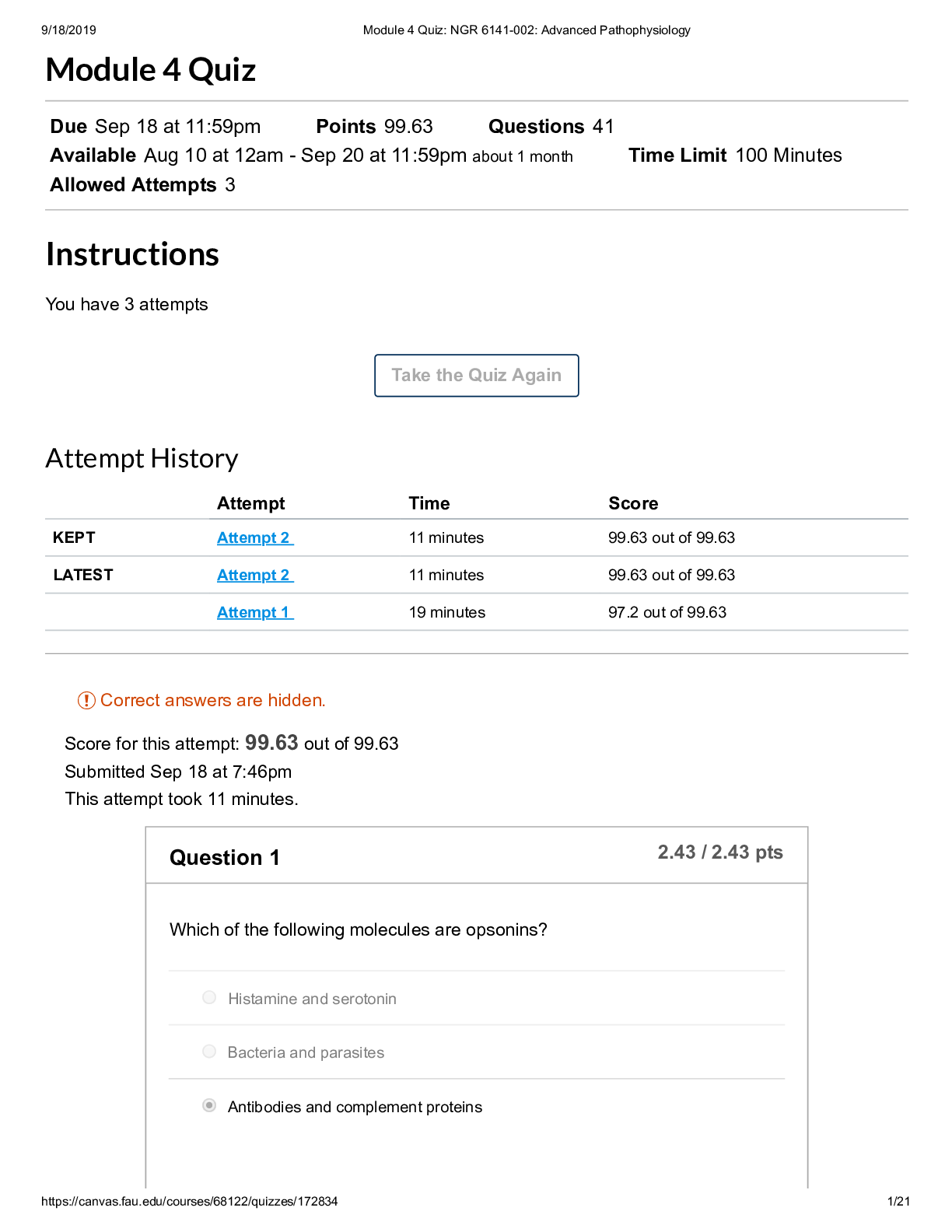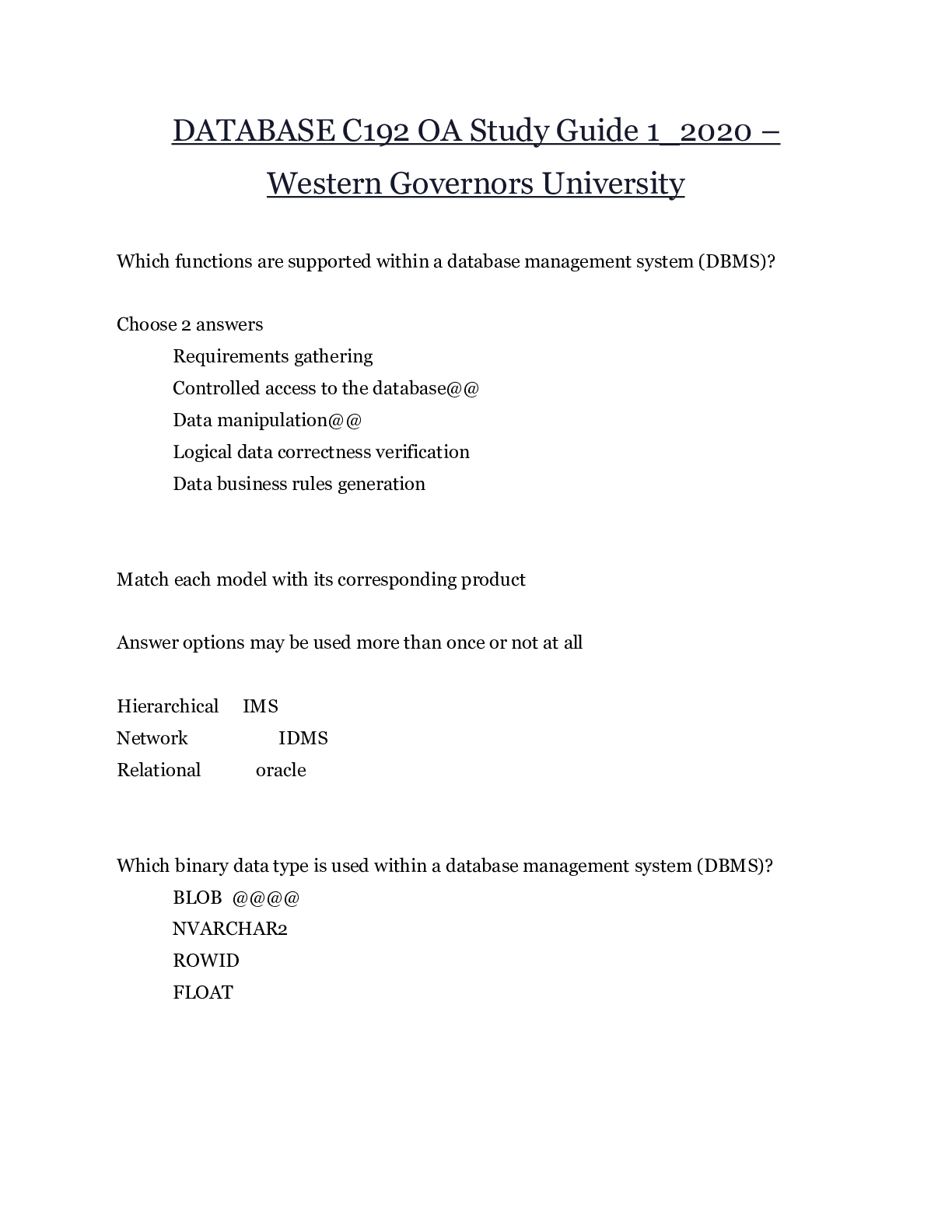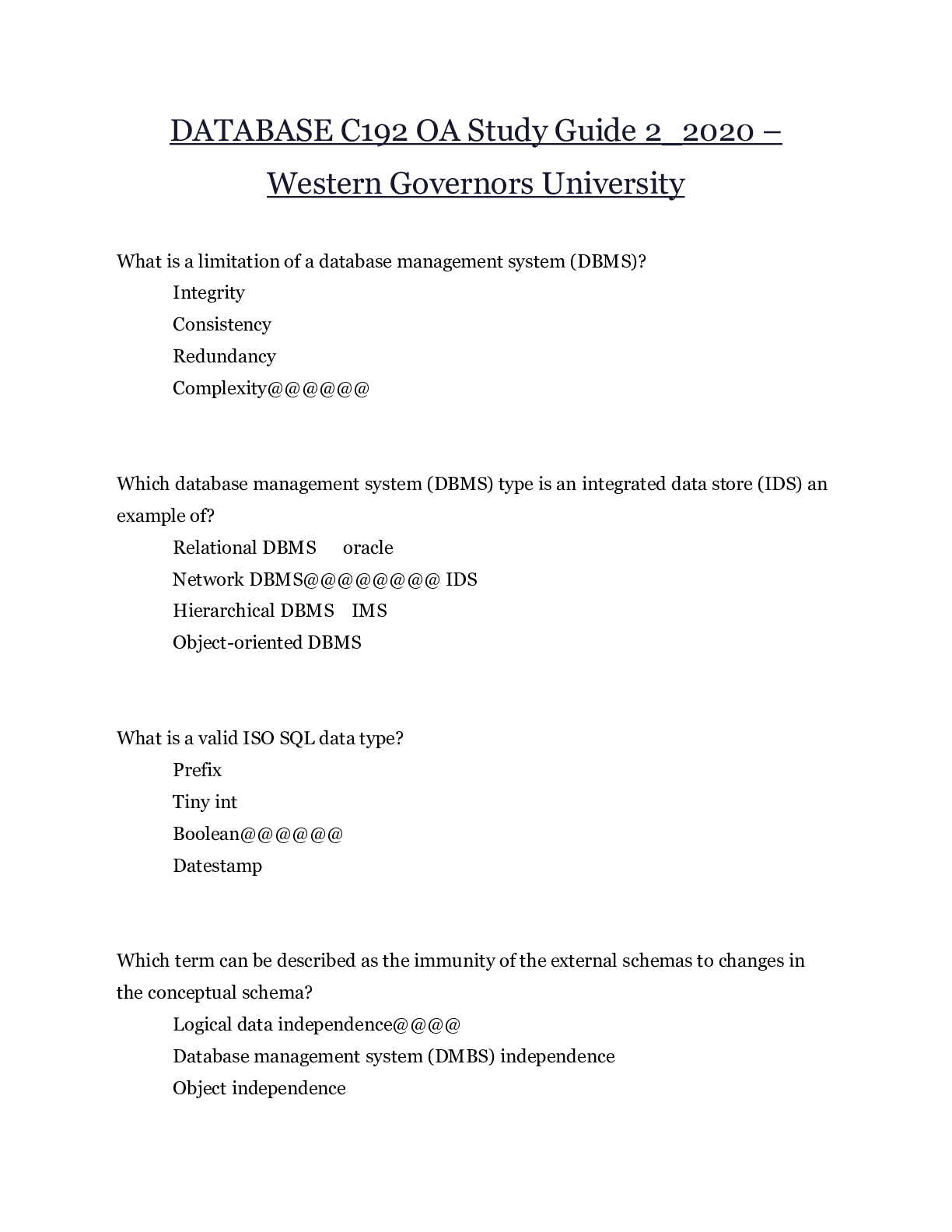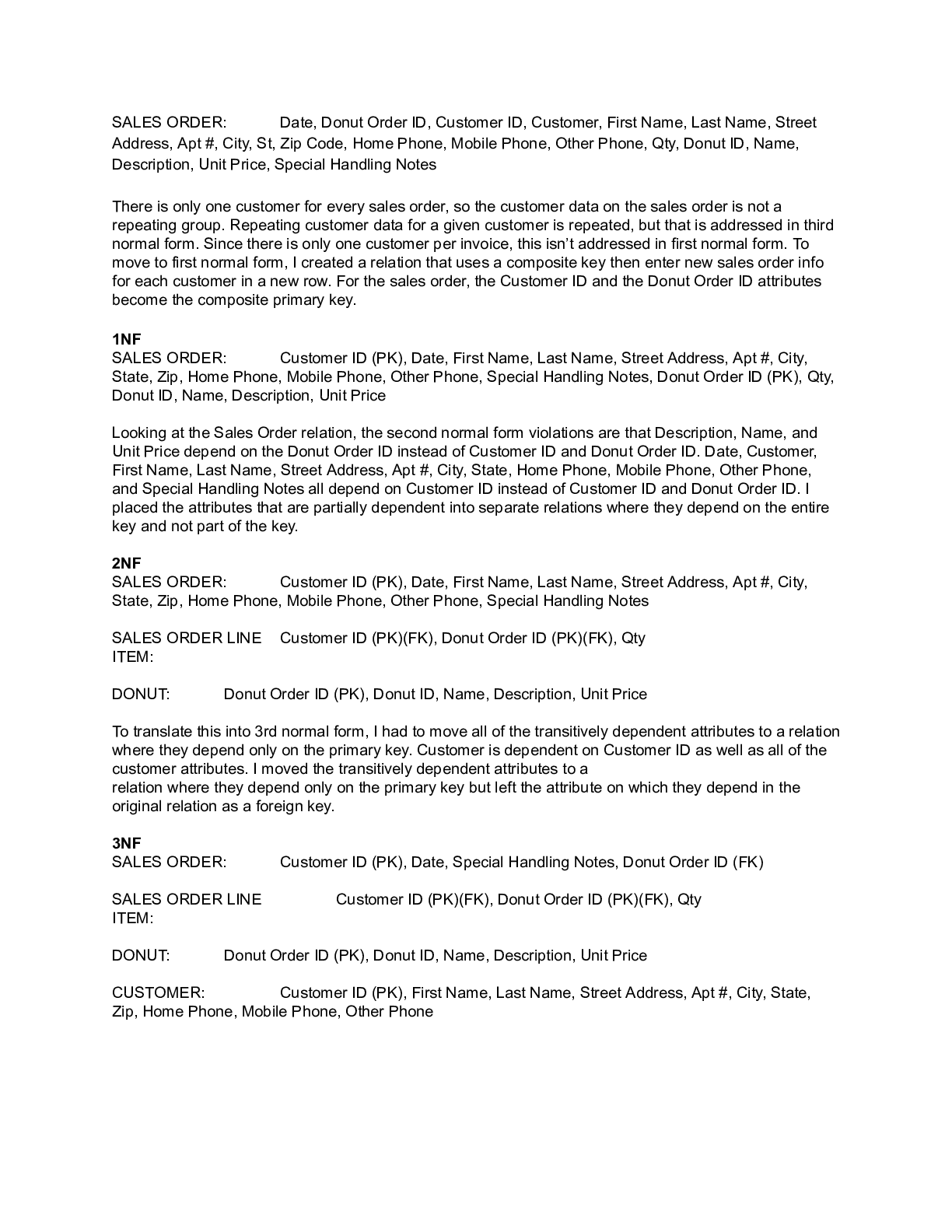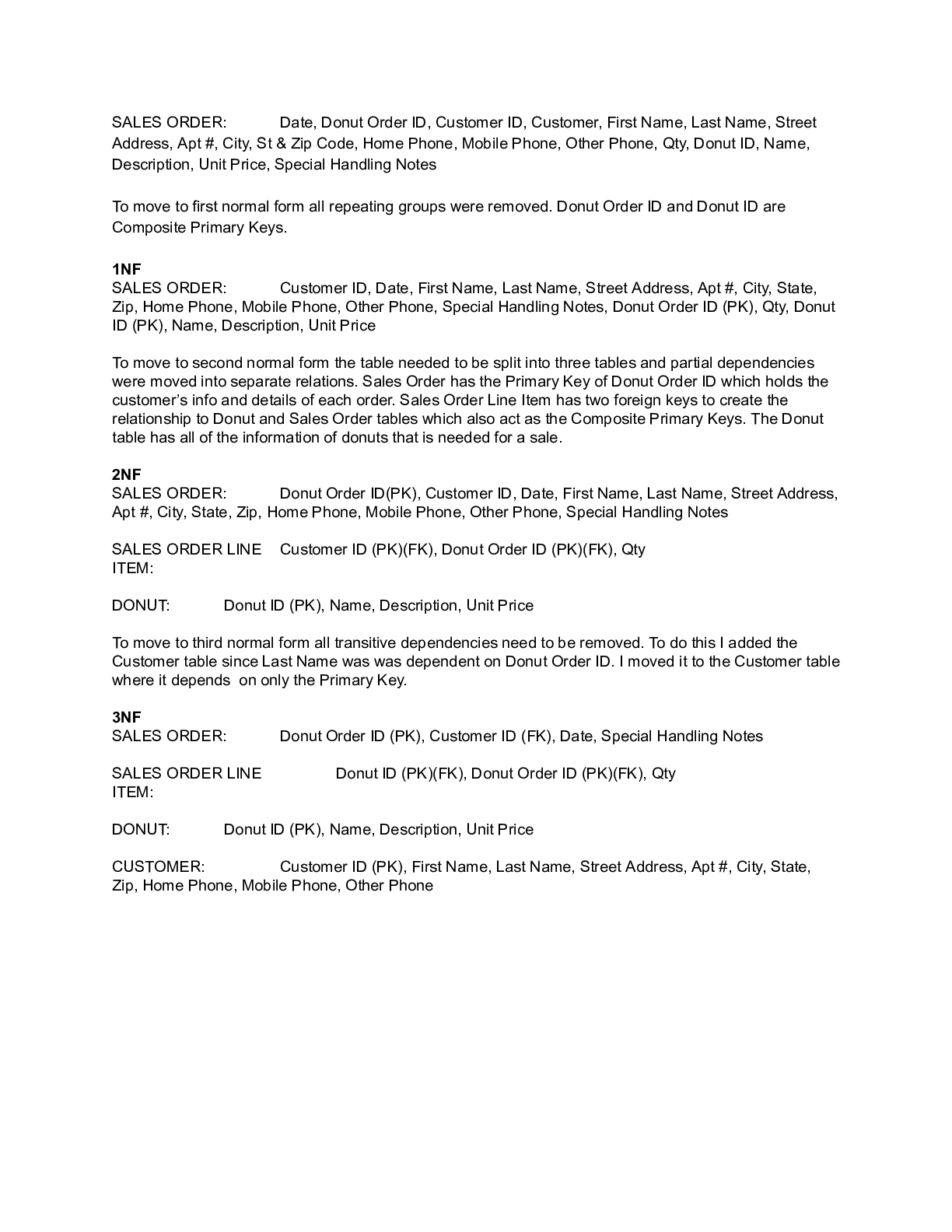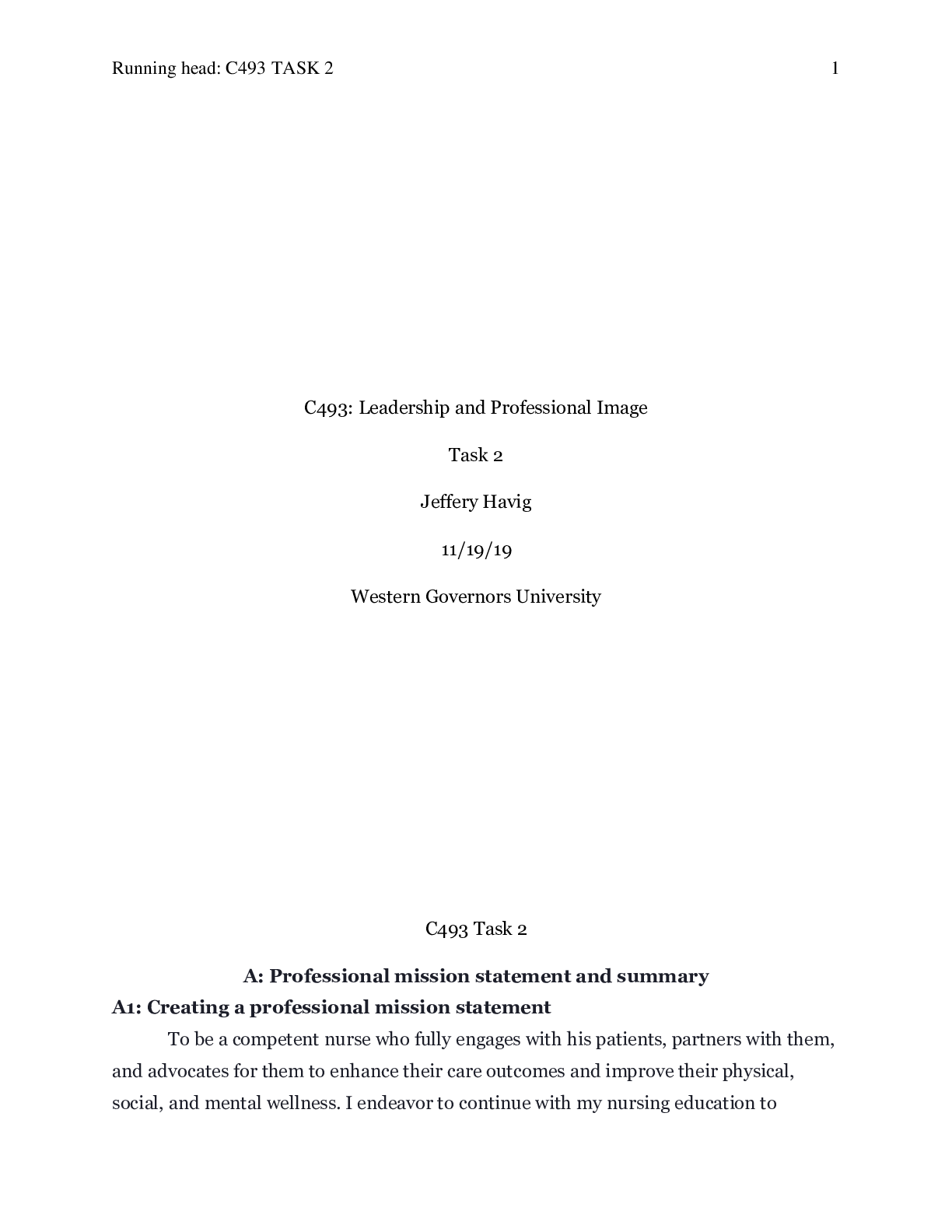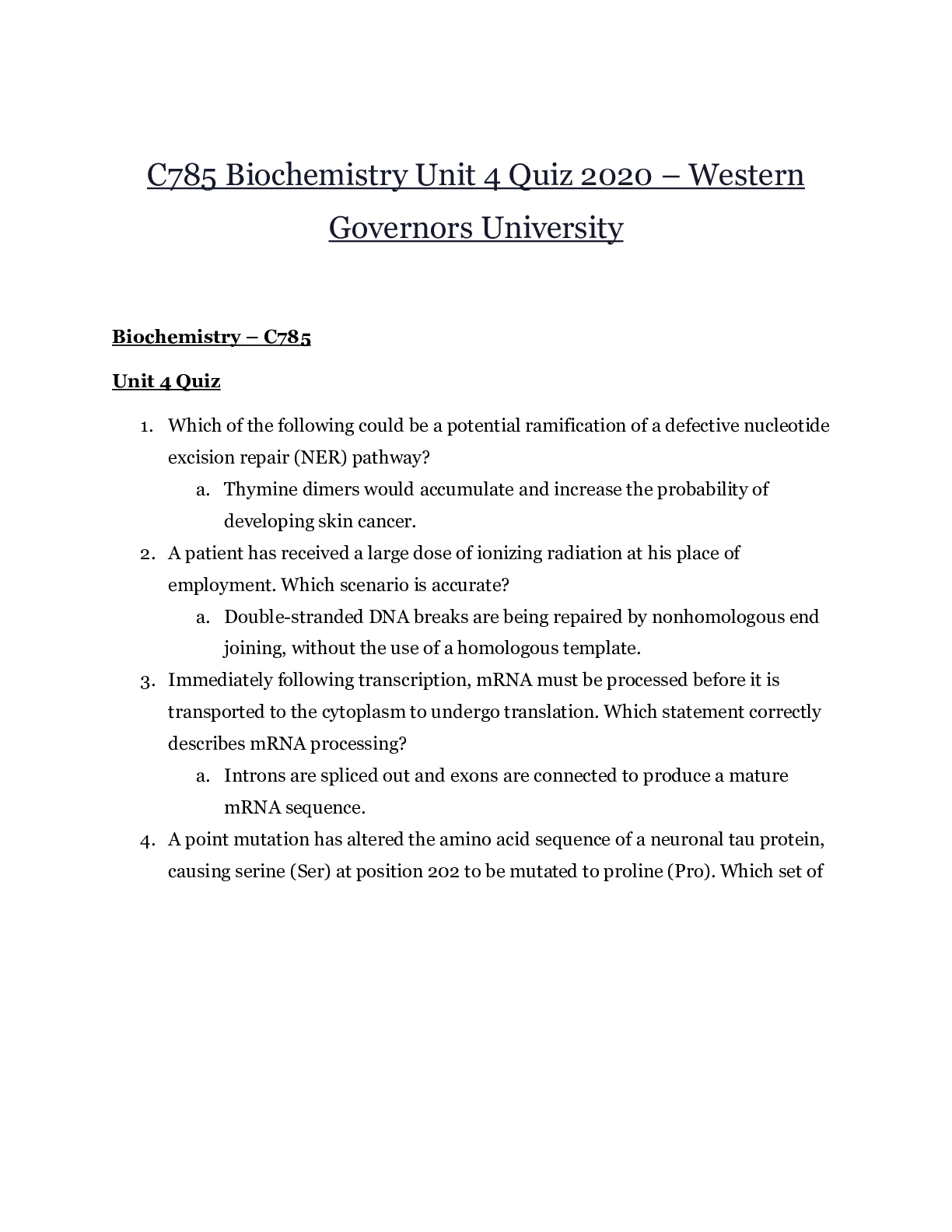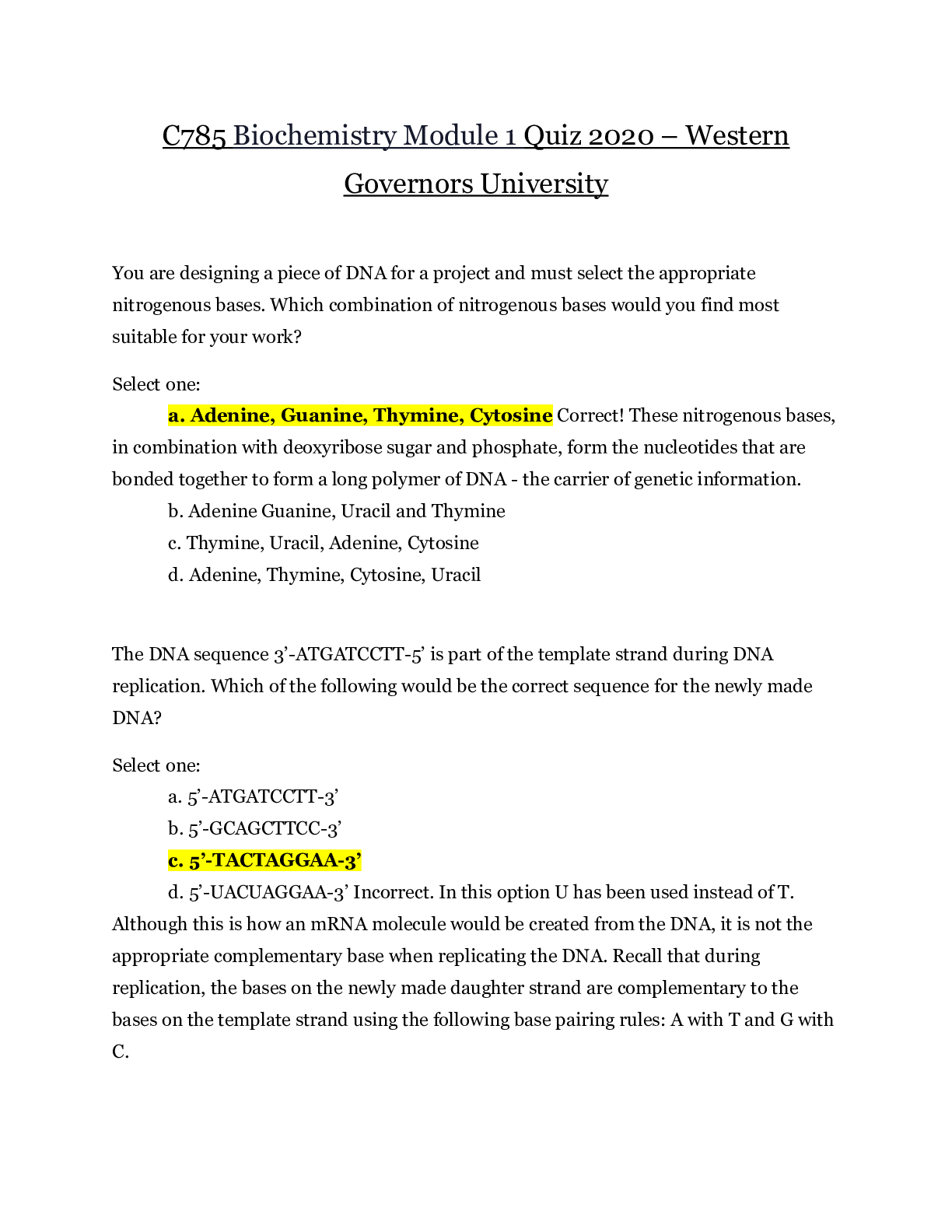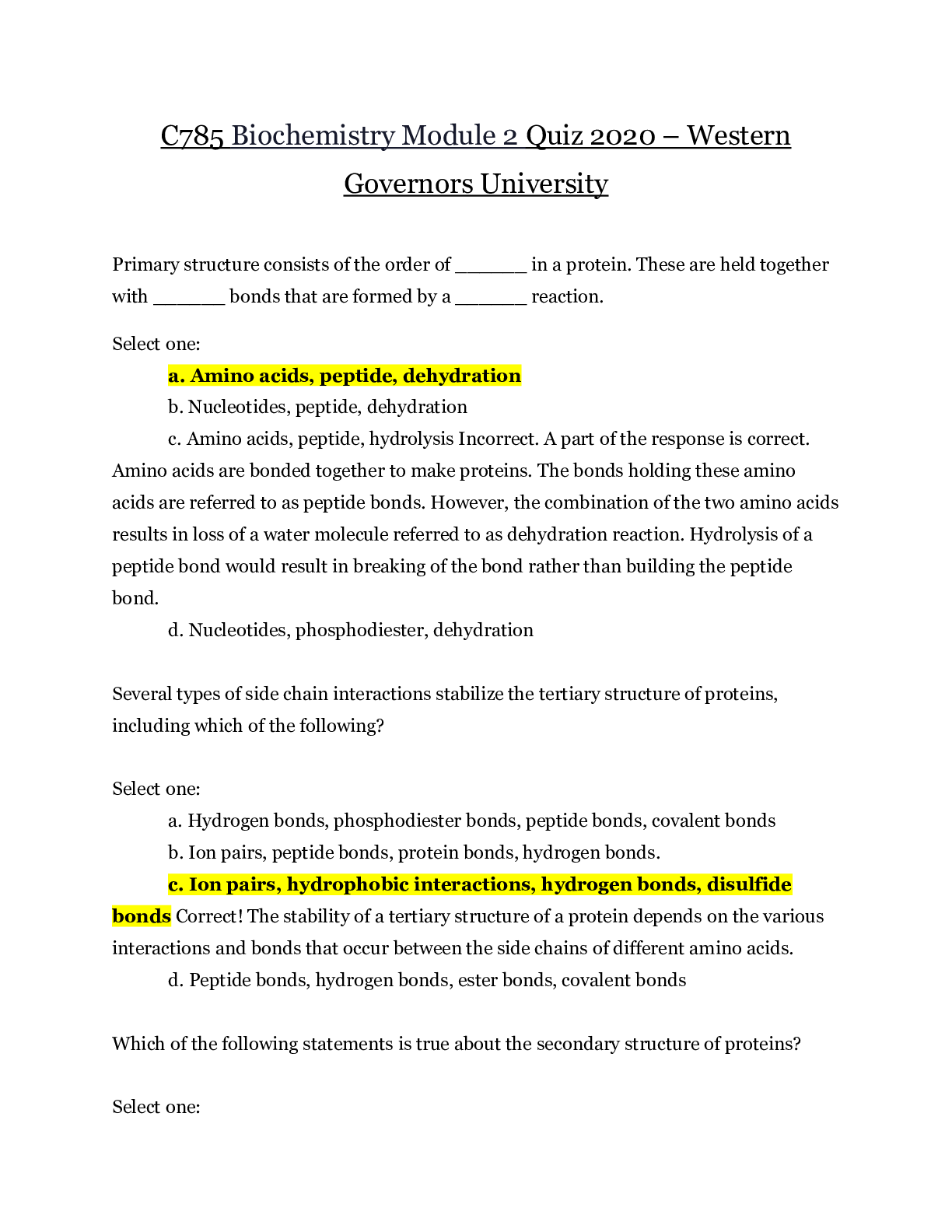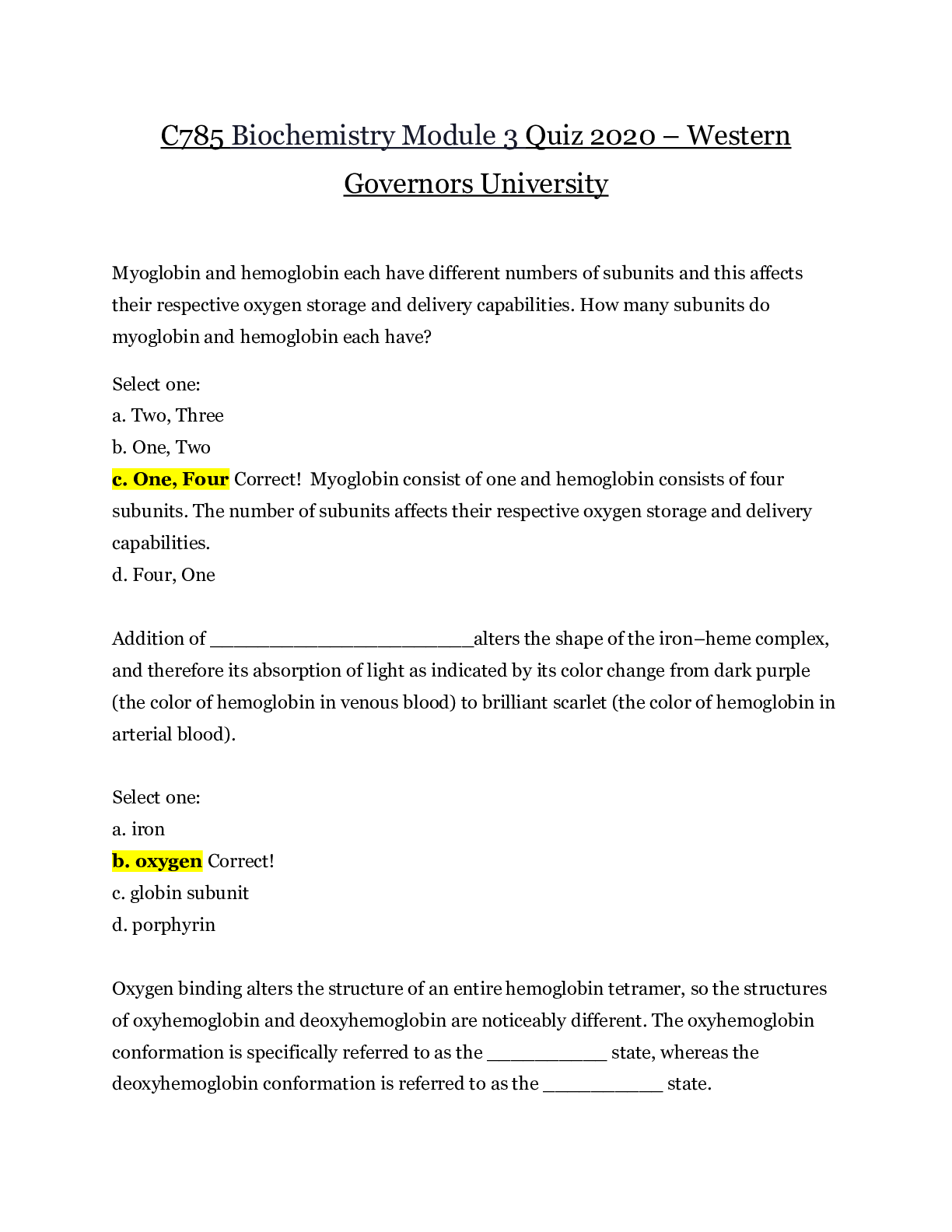BioChemistry > EXAM > Biochemistry C785 Module 4 Quiz 2020 – Western Governors University | Biochemistry C 785 Module 4 (All)
Biochemistry C785 Module 4 Quiz 2020 – Western Governors University | Biochemistry C 785 Module 4 Quiz 2020
Document Content and Description Below
Biochemistry C785 Module 4 Quiz 2020 – Western Governors University The polysaccharide cellulose is composed of sugar monomers linked through ______ linkages, with their CH2OH groups in _________... direction relative to the neighboring monomer. Select one: a. Beta; opposite ! Polysaccharides of nondigestible Carbohydrates (the "fiber" in our diets) are held together by bonds known as beta linkages between individual monosaccharides; their CH2OH groups are orientated in an opposite direction relative to its neighbors. These bonds make cellulose indigestible in our bodies. b. gamma; same c. alpha; opposite d. beta; same Which of the following nutrients cannot be broken down to a substance that can participate in the production of ATP via aerobic cellular metabolism? Select one: a. Vitamin E ! Vitamins are not nutrients that can be broken down in the process of creating ATP; rather they are essential in small quantities to serve as coenzymes or cofactors in enzymatic processes.Vitamin E is an antioxidant b. Lipids c. Protein d. Complex Carbohydrates Glycolysis produces two ATP molecules. Through what process are these ATP molecules made? Select one: a. Substrate level phosphorylation ! The reactions within glycolysis directly form a bond between ADP and Pi to form ATP in the process of substrate level phosphorylation b. Oxidative phosphorylation c. Electron transport chain d. Beta oxidation What product of beta oxidation is able to enter the citric acid cycle? Select one: a. Acetyl CoA ! Acetyl CoA made by the process of beta oxidation enters the citric acid cycle b. Glucose c. Glycerol d. Fatty acyl-CoA What process is shared between anaerobic and aerobic Metabolism ? Select one: a. Glycolysis ! The pyruvate produced in glycolysis will have different fates based on the availability of oxygen, but glycolysis will occur regardless of oxygen's presence or absence. b. Lactate fermentation c. Electron transport chain d. Citric acid cycle A defect occurs that prevents pyruvate from converting to lactate under anaerobic conditions. What is a possible consequence? Select one: a. Glycolysis continues because NAD+ levels are low b. Glycolysis continues because NAD+ levels are high c. Glycolysis stops because NAD+ levels are low d. Glycolysis stops because NAD+ levels are high In. When pyruvate is converted into lactate, NADH is oxidized to NAD+. If this conversion does not happen, NAD+ is not generated. Without NAD+, glycolysis could not continue. Which of the following differentiates aerobic from anaerobic cellular Metabolism ? Select one: a. The breakdown of glucose into compound with fewer carbon atoms b. The utilization of O2 as an electron acceptor ! Only in aerobic respiration is O2 consumed and this occurs in the last step of the electron transport chain. Oxygen acts as the final electron acceptor and forms water during this step c. The production of ATP d. The use of ingested food to create energy Which of the following processes does NOT take place in the mitochondria of a cell? Select one: a. Production of FADH2 b. Conversion of pyruvate to lactic acid ! When oxygen is scarce, pyruvate--created through glycolysis---remains in the cytosol and will be converted anaerobically into lactate (fermentation) c. Creation of a proton gradient d. Production of CO2 in the citric acid cycle Under anaerobic conditions in humans, which molecule is formed in the cytosol by fermentation? Select one: a. Glucose-6-phosphate b. Acetyl-CoA c. Lactate ! When there is no oxygen available for cellular respiration, for example, during strenuous muscular exercise, the pyruvate formed via glycolysis will be fermented into lactic. The lactate will be sent to the liver for conversion back into glucose via the Cori cycle d. Fructose A woman is about to begin her ascent of Mount Everest and is preparing for Day 1 of the climb. Approximately 6 hours before the hike begins, she and her climbing team eat a meal containing 80% complex Carbohydrates. What is the physiological benefit of this approach? Select one: a. Improving glycogen stores in liver and muscle ! The complex Carbohydrates will be broken down in the digestive track to monosaccharides (glucose) and absorbed into the bloodstream. Since that dietary glucose is not immediately needed for ATP (the hiker has yet to begin the long hike), glycogen will be made. b. Increasing glycolysis in the hours leading up to the hike c. Raising insulin levels d. Stimulating the pancreas to release glucagon Which process is stimulated when glucagon is released into the bloodstream? Select one: a. Triglyceride synthesis b. Glycogenesis c. Glucose uptake d. Glycogenolysis ! Glycogenolysis is the process of splitting glycogen into glucose subunits. Glucagon will be released from pancreas when blood glucose levels are low and will stimulate BOTH glycogenolysis AND gluconeogenesis, both of which will raise blood glucose levels. Which of the following chemical formulas represents a monosaccharide? Select one: C6H12O6 ! All Carbohydrates have general formula CxH2xOx. Another way to think about it is that all are composed of equal parts Carbo ("Carbon") & water ("hydrate") CH3(CH2)4COOH NH2CH2COOH C6H6O6 A patient with advanced cancer has not been able to eat a full meal for the past three months, and his intake has gradually diminished over the last month such that his entire intake in the prior three days consists solely of water. Which of the following is most likely? Select one: a. Glycogen is his major source for producing ATP In. Glycogen stores in the liver will be depleted fairly quickly (many hours to a few days) b. Fatty acid synthesis is favored over beta oxidation of fatty acids c. His blood sugar level will be very high d. He is likely to have lost adipose tissue and muscle mass Which process is stimulated when insulin is released into the bloodstream? Select one: a. Glycogenesis b. Glucagon c. Glycogenolysis In. Insulin is released in response to elevated blood glucose; processes that decrease blood glucose would be favored by insulin release. Glycogenolysis is the process of breaking down glycogen into glucose. It would not be stimulated by insulin. d. Gluconeogenesis What is the largest source of energy storage in the normal human body? Select one: a. Triglycerides in adipose b. Triglycerides in liver c. Glycogen in the liver In. Glycogen is the storage form of glucose. However, the glycogen stores are limited and when they are depleted within a day or so, the body relies on triglyceride storage for ATP production d. Cholesterol in cell membranes Which of the following drives glucose from the bloodstream into cells? Select one: a. carbon monoxide b. Glycogen c. High fat diet d. Insulin ! When insulin binds to its receptor on cell membranes, it stimulates the translocation of GluT4 to the cell membranes. This allows glucose from the bloodstream to enter the cell Which of the following chemicals can be produced in dangerous excess in a patient taking metformin because of its effect of decreasing the liver’s participation in the Cori cycle? Select one: a. Insulin b. methionine c. Lactic acid ! Metformin decreases gluconeogenesis in the liver, thus contributing to its blood glucose-lowering effect. However, this leads to decreased ability to convert lactate, produced by anaerobic Metabolism especially in muscles, back into glucose. If lactate builds up excessively, lactic acidosis can occur d. Glucose A two year-old boy is found to have an autosomal recessive glycogen storage disease that prevents him from being able to fully metabolize glucose. On examination, he has an enlarged liver and bulky appearing muscles. Biopsy of both the liver and the muscles shows markedly increased amounts of glycogen compared to normal. Which of the following is TRUE? Select one: a. So as to prevent too high a blood glucose level, the child’s meals should be separated by 12 hours. b. Since glucose can be partially but not fully metabolized, there is an increased concentration of the intermediate compounds and this causes a shift in enzymatic reactions, favoring the production of glycogen. c. His abnormal physical exam findings are because he has excessive synthesis of fatty acids and increased production of triglycerides. In. His liver and muscles will have excessive storage of non utilizable glycogen. He will have increased breakdown of adipose (and protein) in order to have a metabolic source for creating ATP. d. If his parents have another child, there is a 50% risk that the child will also have the disease. Sucrose is a disaccharide consisting of one molecule of glucose bound to one molecule of fructose. When you put sucrose in your tea, how is that sucrose utilized by your body for making energy (ATP)? Select one: a. Sucrose is not a potential source of energy b. Sucrose molecules can be directly bonded together to form a larger molecule called glycogen c. Sucrose is broken down into its constituent monosaccharides for absorption; these can then be metabolized via glycolysis and the citric acid cycle ! Sucrose will be broken down into glucose and fructose and then absorbed. Glucose can directly enter glycolysis and in the presence of oxygen the citric acid cycle. Fructose indirectly can indirectly enter glycolysis. d. Sucrose is converted into glucagon to raise blood sugar Which of the following directly provides the energy necessary for the conversion of ADP + P to ATP by ATP synthase? Select one: a. Protons moving down a concentration gradient from the intermembrane space to the mitochondrial matrix ! As hydrogen ions flow back into the mitochondrial matrix from the intermembrane space, the enzyme ATP synthase harnesses the energy from this flow of protons to generate ATP from ADP + P. b. Oxygen binding to protons to form water c. FADH2 transferring a high energy electron to Protein Complex II d. Cytochrome c accepting an electron from NADH If a patient is healthy and has a normal oxygen concentration in her blood, approximately how many ATP are produced for every molecule of glucose that is aerobically metabolized? Select one: a. 30 ! 2 ATP from substrate level phosphorylation in glycolysis + 2 (citric acid cycle by substrate level phosphorylation) + approximately 26 (electron transport chain by oxidative phosphorylation) = approximately 30 ATP formed from one molecule of glucose aerobically metabolized. b. 2 c. 4 d. 6 What process takes place in the inner membrane of the mitochondria? Select one: a. Electron transport chain ! Protein complexes and other molecules that compose the electron transport chain are found in the inner membrane of the mitochondria. It is here where electrons are passed from component to component to create a proton gradient. b. glycolysis c. beta oxidation d. lactate fermentation While barbiturates are potent inhibitors of Complex I in the Electron Transport Chain, they do not completely block electron transport because___________. Select one: a. FADH2 donates electrons to Complex II ! While barbiturates inhibit activity of Complex I, therefore blocking NADH-dependent electron transport, Complex II continues to accept electrons from FADH2 and pass them onto CoQ10, thus partially maintaining the electron transport chain activity. b. FADH2 donates electrons to Complex I. c. of increased activity of Coenzyme Q10. d. NADH is able to interact directly with Complex II Where is energy stored in an ATP molecule? Select one: a. In the bonds between the phosphate groups ! ATP consists of an adenosine molecule (adenine + ribose) and 3 phosphate groups. The bonds between the phosphates are very high energy, especially between the 2nd & 3rd phosphate. Energy is released when the phosphate bonds are broken b. In the bond between the adenosine molecule and the 1st phosphate c. In the adenine nitrogenous base portion of the adenosine molecule d. In the sugar portion of the adenosine molecule A defect in an enzyme in the citric acid cycle causes the cycle to stop functioning. What are possible consequences? Select one: a. Decreased levels of acetyl-CoA b. Increased levels of ATP c. Decreased levels of ATP d. Increased levels of NADH In. NADH and FADH2 are generated from the citric acid cycle and continue to the electron transport chain where ATP can be made through the process of oxidative phosphorylation. A defect in an enzyme in the citric acid cycle prevents NADH and FADH2 production.Therefore, levels of NADH would decrease, not increase. [Show More]
Last updated: 1 year ago
Preview 1 out of 9 pages

Buy this document to get the full access instantly
Instant Download Access after purchase
Add to cartInstant download
We Accept:

Reviews( 0 )
$12.00
Document information
Connected school, study & course
About the document
Uploaded On
Nov 23, 2020
Number of pages
9
Written in
Additional information
This document has been written for:
Uploaded
Nov 23, 2020
Downloads
0
Views
48














